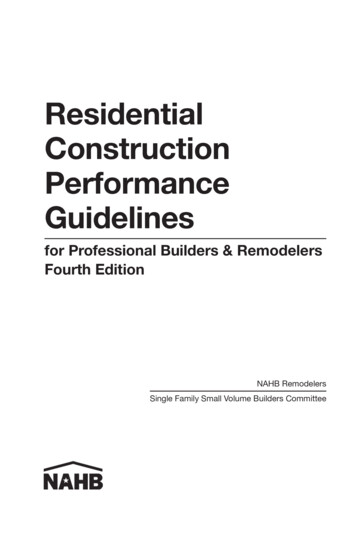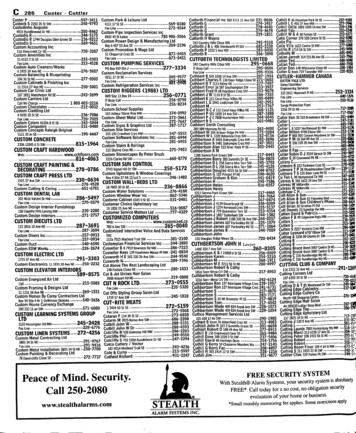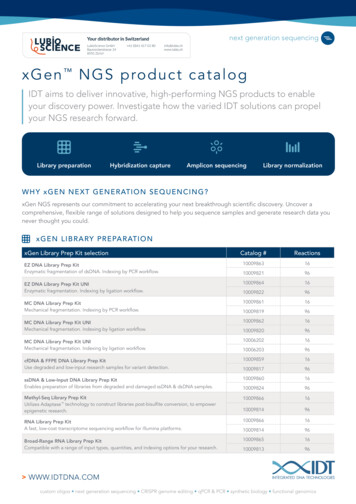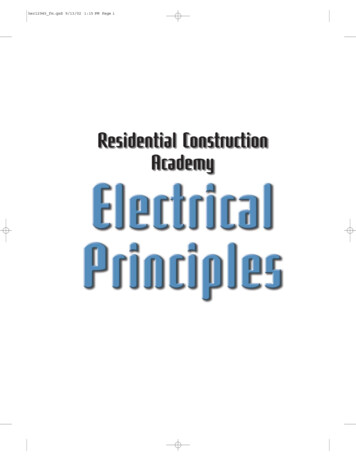
Transcription
ResidentialConstructionPerformanceGuidelinesfor Professional Builders & RemodelersFourth EditionNAHB RemodelersSingle Family Small Volume Builders Committee
Residential Construction Performance Guidelines for ProfessionalBuilders & Remodelers, Fourth EditionBuilderBooks, a Service of the National Association of Home BuildersCourtenay S. BrownDirector, Book PublishingNatalie C. HolmesBook EditorTorrie L. SingletaryProduction EditorG! GraphicsCover DesignRonda QuillenCompositionMcNaughton & Gunn Inc.PrintingGerald M. HowardMark PursellLakisha CampbellJoshua NesterDavid CrumpAgustín CruzNAHB Chief Executive OfficerNAHB Senior Vice President, Marketing & Sales GroupNAHB Vice President, Publishing & Affinity ProgramsProject ManagerLegal ReviewExecutive Director, Business Management DepartmentDisclaimerThis publication provides accurate information on the subject matter covered. The publisher isselling it with the understanding that the publisher is not providing legal, accounting, or otherprofessional service. If you need legal advice or other expert assistance, obtain the services of aqualified professional experienced in the subject matter involved. Reference herein to any specificcommercial products, process, or service by trade name, trademark, manufacturer, or otherwisedoes not necessarily constitute or imply its endorsement, recommendation, or favored status bythe National Association of Home Builders. The views and opinions of the author expressed in thispublication do not necessarily state or reflect those of the National Association of Home Builders,and they shall not be used to advertise or endorse a product. 2011 by NAHB. All rights reserved. No part of this book may be reproduced or utilized in anyform or by any means, electronic or mechanical, including photocopying and recording or by anyinformation storage and retrieval system without permission in writing from the publisher.Printed in the United States of America14 13 12 111 2 3 4 5ISBN-10: 0-86718-670-4ISBN-13: 978-0-86718-670-3Library of Congress Cataloging-in-Publication DataNational Association of Home Builders (U.S.). Remodelors Council. Single Family Small VolumeBuilders Committee.Residential construction performance guidelines for professional builders & remodelers/NAHBRemodelers and Single Family Small Volume Builders Committee. -- 4th ed.p. cm.Includes index.ISBN 978-0-86718-670-31. Dwellings--Remodeling--Standards--United States. I. Title.TH4816.N37 2011690’.837021873--dc222010019539For further information, please contact:National Association of Home Builders1201 15th Street, NWWashington, DC 20005-2800800-223-2665Visit us online at www.BuilderBooks.com.
ContentsAcknowledgments. viiIntroduction.xiHistory of the Residential Construction Performance Guidelines .xiFourth Edition Review .xiScope of the Residential Construction Performance Guidelines . xiiScope of Responsibilities . xiiiRemodeling Projects. xivHow to Use This Manual. xivGeneral Instructions.xvDefinition of Terms .xvIncorporating the Guidelines into a Warranty orDispute Resolution Program . xviOther Uses for the Guidelines. xviiTaking Measurements . xviiAdapting a Carpenter’s Level . xviiComments Welcomed . xviii1.Site Work. 12.Foundation. 3General . 3Concrete Slabs . 4Concrete Block Basement and Crawl Space Walls . 6Poured Concrete Basement and Crawl Space Walls . 7Moisture and Water Penetration . 9Basement Walls and Floor . 9Crawl Spaces . 10Structural Columns, Posts, or Piers. 113.Interior Floor Construction . 13Floor System . 13Beams, Columns, and Posts . 13Subfloor and Joists . 144.Walls . 19Wall Framing . 19Moisture Barriers and Flashing . 20Wall Insulation . 20Windows and Glass . 21Exterior Doors . 22iii
5.Exterior Finish . 29Wood and Wood Composite Siding . 29Aluminum or Vinyl Siding . 31Cement Board Siding . 34Masonry and Veneer . 35Stucco and Parged Coatings. 37Exterior Trim . 39Paint, Stain, and Varnish . 406.Roof . 41Roof Structure . 41Roof Sheathing . 42Roof Vents . 43Roof Coverings . 43Chimney . 47Gutters and Downspouts . 48Skylights . 487.Plumbing . 51Water Supply System . 51Plumbing Fixtures . 52Sanitary Sewer or Septic System . 548.Electrical . 57Fuses and Circuit Breakers. 57Outlets and Fixtures. 589.Interior Climate Control. 61Air Infiltration and Drafts . 61Humidity Control and Condensation . 62Ducts and Airflow. 62Heating and Cooling Systems . 63Ventilation . 6610.Interior Finish . 69Interior Doors . 69Interior Stairs. 71Trim and Moldings . 73Cabinets. 75Countertops . 77Interior Wall Finish. 81Lath and Plaster . 81Gypsum Wallboard or Drywall . 81Paint, Stain, and Varnish . 83Wallpaper and Vinyl Wall Coverings. 85iv
11.Flooring . 87Carpeting . 87Vinyl Flooring . 88Hardwood Flooring . 91Tile, Brick, Marble, and Stone Flooring . 9412.Miscellaneous . 97Fireplace and Wood Stove. 97Concrete Stoops and Steps . 98Garage . 99Driveways and Sidewalks . 100Wood and Composite Decks . 10213.Landscaping . 105Appendix — Sample Contract Language . 107Residential Construction Performance Guidelines in Disputes . 107Arbitration Clause . 107Residential Construction Performance Guidelines in Express Warranty . 108Glossary . 109Resources . 115BuilderBooks . 115Biztools . 115Index . 117v
AcknowledgmentsNAHB gratefully acknowledges the leadership and commitment of the two groupsthat worked together to produce this publication and its predecessors:Residential Construction Performance Guidelines, Fourth Edition:Nicole Goolsby, CGP, Chair, RCPG Work Group; Chair, Single Family Small VolumeBuilders CommitteeReview SubgroupBob Bell, CAPS, CGRSam Bradley, CAPS, CGR, GMB, CGPJohn C. CochenourTom GotschallBob Hanbury, CGRBob MerzRichard G. ReynoldsJ. Bradley SimonsWork GroupJess Hall, CGB, CGPBuddy HughesJay CarlsonPeter MerrillPaul Michelsohn Jr., CGPJohn Moffitt Jr.Joanne (Jo) Theunissen, CGPJohn PeaveyChuck Miller, MIRM, CMP, CGB, GMB, CSP, MCSP, CGPGretchen PalmerAlan Hanbury, CGR, CAPS, CGPLawrence CramerDon Pratt, CAPS, CGB, CGR, CGPMichael TurnerBill AllenJohn Piazza, Sr., CAPSTony ThompsonRoger LangfordRandy RinehartDaimon Doylevii
Residential Construction Performance Guidelines, Third Edition:John H. Moffitt, Jr., Work Group Chair, Single Family Small Volume BuildersCommittee ChairDouglas Sutton, Sr., CGR, CAPS, Chair, NAHB RemodelersWork Group LeadersRobert Bell, CGR, CAPSDaimon Doyle, GMB, CAPSRobert T. MerzRichard G. ReynoldsJ. Bradley SimonsOthersJohn KubikJanet WilliamsNelson VaughanThis book would not exist today had it not been for the original outstandingcommitment from the following individuals and organizations who produced the firstedition of Residential Construction Performance Guidelines:Bill Asdal, Chair, NAHB RemodelersSuzanne Grove, Chair, Single Family Small Volume Builders CommitteeWork Group LeadersRobert Bell, CGRNorm Hutchens, CGRRobert T. MerzJohn J. Piazza Sr.The following organizations and groups contributed to all editions of the ResidentialConstruction Performance Guidelines:NAHB Research CenterNAHB RemodelersNAHB Standing CommitteesBuilding Product IssuesBusiness Management & Information TechnologyConstruction, Codes & StandardsConstruction Safety & HealthCustom Home BuildersSingle Family Production BuildersSingle Family Small Volume Buildersviii
Other OrganizationsBonded Builders Home Warranty AssociationBuilders Association of Greater IndianapolisBuilding Industry Association of WashingtonCanadian Home Builders AssociationGreater Atlanta Home Builders AssociationHome Buyers Warranty CorporationMacLellan Wolfson AssociatesMetropolitan Builders Association of Greater MilwaukeeMichigan Association of Home BuildersPortland Cement AssociationProfessional Warranty Service CorporationQuality Builders Warranty CorporationResidential Warranty CompanySouthern Nevada Home Builders AssociationTexas Association of BuildersTexas Residential Construction CommissionTile Council of America2-10 Home Buyers Warranty, Inc.U.S. Department of Housing and Urban Developmentix
IntroductionBeyond building codes and local regulations, both contractors and their customershave long sought measurable benchmarks that deal with the expectations ofperformance in the goods and services provided by the residential constructionindustry. Although codes and regulations address matters of health, safety, andwelfare, matching a consumer’s expectations entails having objective criteriaregarding performance. Upon this premise, the Residential Construction PerformanceGuidelines were developed and refined to offer achievable minimum levels ofworkmanship for the products delivered.History of the Residential ConstructionPerformance GuidelinesThe core of these criteria was first established as a basis for coverage under theinsured warranty program, initially offered some 30 years ago. More than 20 yearsago, the NAHB Remodelers (previously the Remodelors Council) embraced a similarcompilation of guidelines, which led to the published editions of Quality Standardsfor the Professional Remodeler. The joint effort of the NAHB Remodelers and theSingle Family Small Volume Builders Committee culminated in the first edition ofthese guidelines in 1996. Many of the individual guidelines have remained timehonored measures of residential construction performance.Indeed, the Residential Construction Performance Guidelines have become theaccepted tool in many locations throughout the country for evaluating performanceby parties under residential construction contracts when a dispute may lead tolitigation or arbitration.Fourth Edition ReviewThe performance guidelines in this manual were initially created and reviewed bymore than 300 builders and remodelers, as well as representatives of specialty tradeorganizations. This exhaustive review resulted in a first edition that builders andremodelers used as a reference with confidence as they communicated with theircustomers. Subsequent editions, including this one, are substantially similar to theinitial publication, although certain guidelines have been updated to make themeasier for both contractors and consumers to understand.A few guidelines were deleted and others were added to make the text morecomprehensive and consistent with current building science advancements. NAHBmembers strive to continually refine these guidelines to promote greater mutualxi
understanding of expectations between contractors and their customers. It ishoped that this will reduce the potential for disputes throughout the construction/remodeling process.Scope of the Residential ConstructionPerformance GuidelinesThese guidelines are a collection of minimum performance criteria and should beinterpreted as such. Many contractors routinely build to tighter tolerances than thoseexpressed here. Moreover, the guidelines are intended as a reference that shouldbe interpreted with common sense. They should be applied only within the scope ofthe particular project being performed; they are not intended to answer all questionspertaining to construction workmanship that might arise in the course of a typicalresidential construction project. The guidelines selected for this manual deal with theissues that most frequently prompt questions for the contractor and the consumer.The developers of these guidelines examined typical building techniques and qualitymeasures based on a general overview of residential construction within the UnitedStates. Local variation in construction techniques, materials, requirements, andenvironmental conditions may render the application of some of these guidelinesinappropriate either for evaluation or suggested remedy. In such cases, the partiesshould expressly provide in writing that some standard other than the relatedguideline will apply. Similarly, if a specific problem has prompted locally developedguidelines or practices, or changes in the prevailing building code, the parties maywant the local guideline, practice, or code to take precedence over these guidelines.These guidelines neither constitute nor are they intended to substitute for a warranty.However, parties may agree to incorporate the guidelines by referencing them withina warranty or within another construction contract provision. The guidelines areseparate and distinct from any manufacturers’ or fabricators’ warranties that mayapply to materials and products used in a project.Contractors often refer to these guidelines in the Dispute Resolution sections of theircontracts as the first step, prior to invoking any formal dispute resolution processsuch as mediation, arbitration, or litigation. In reality, using these guidelines asthe basic performance criteria has eliminated the need to invoke a formal disputeresolution process in many cases.The use and application of the Residential Construction Performance Guidelinesis strictly optional and completely at the discretion of individual users. If they areused, they refer only to contractor-installed materials and services and not to anyelements the consumer has contracted for through a third party, including other tradecontractors.xii
Nothing in this manual should be construed as a policy, endorsement, warranty(express or implied), or guaranty by the National Association of Home Builders(NAHB) or any of its members or other persons or organizations involved in thecreation of this manual, with respect to any technical descriptions, systems, details,requirements, materials, or products.NAHB accepts no responsibility for any inaccuracies or omissions and expresslydisclaims any responsibility for damage, liability, loss, or risk, whether personal,financial, or otherwise, that is incurred as a direct or indirect consequence of using,applying, or relying on any of the recommendations and/or information contained inthis manual.Scope of ResponsibilitiesTypically, numerous parties are involved in a residential construction project, whetherit entails building a new home or remodeling an existing one. Each of these partieshas specific responsibilities to fulfill. The contract documents should provide a clearstatement of the agreement between the contractor and the consumer. In addition tothe specific provisions of any contract, the following general responsibilities shouldbe noted:Contractor: For the purposes of this manual, the contractor is the entity named inthe contract that has primary responsibility for completing the project. The contractoroften employs others to assist in the project. In most cases, the contractor isresponsible for all work assigned in the contract regardless of who actually performsthe work. If the contractor is acting in a special role (for instance, as a constructionmanager), or the consumer selects others to work on the project who are outside thecontractor’s control, then the responsibility for evaluation and remedy of potentialproblems may fall to other parties.Consumer: The consumer is the buyer of the product or service named in thecontract. As such, the consumer is responsible for carefully reviewing the contractto ensure it accurately represents the expectations for the final product. Once theconsumer accepts the project and moves into the home or occupies the newlyrenovated space, then the consumer is responsible for routine maintenance andupkeep. Homes require a certain amount of care and maintenance, which are theconsumer’s responsibility. Consumers should note that in some of the guidelinescontained herein, the contractor is not obligated to make repairs to items that fallwithin the consumer’s maintenance responsibilities.Manufacturer: Manufacturers warrant many residential construction componentsthat may fall outside the scope of the contractor’s responsibilities, such as kitchenappliances, furnaces, air conditioners, and lighting and plumbing fixtures. Certaintypes of siding, roofing, or flooring also may be covered by a manufacturer’swarranty. If there is a warranty question with one of these components, thexiii
consumer should be aware that the contractor may not be responsible for theproduct’s performance after installation. If a problem occurs, the consumer often willneed to contact the manufacturer or fabricator directly to have the problem evaluatedand, if necessary, rectified, unless otherwise specified in a contract. The contractor’sresponsibilities may end once the contractor provides the appropriate informationon how to contact the manufacturer or fabricator, unless otherwise specified in thecontract.Remodeling ProjectsRemodeling, the process of expanding or enhancing an existing structure, presentsinherent difficulties in melding the new and old into a home or room that meetsthe consumer’s needs and is aesthetically pleasing. Some circumstances call forthe suspension of some or all of the guidelines in order to successfully complete aremodeling project. These circumstances include, but are not limited to, the meetingof old, out-of-plumb or out-of-level structures with new structures; the appearanceof new materials near weathered, existing materials; and the practical considerationsfor new projects to work within the limitations of existing buildings.Because of the unique challenges of joining new and old construction, a remodelingcontractor may build some or all of the project outside the scope of these guidelinesto achieve the contract objectives. When it is reasonable, the contractor may noteand discuss a condition with the consumer before construction. It is also normalfor a contractor, during the course of construction, to discover and accommodateconditions in the old structure that require different solutions from those suggestedin these guidelines. In these circumstances, the governing factor is meeting theneeds of the consumer as outlined in the contract, and complying with the prevailingbuilding code.How to Use This ManualThis manual is divided into chapters organized according to the usual sequence ofevents in the construction process. Nearly every chapter contains sections withinit, and some chapters also have more specific subsections. Each chapter containsindividual construction performance guidelines.The guidelines are numbered as follows:Chapter Number–Section Number–Guideline NumberEach construction performance guideline has three parts, as follows:Observation: A description of a particular construction condition.xiv
Performance Guideline: The specific criterion for acceptable workmanship.Corrective Measure: A description of the work required by the contractor to meetthe performance guideline and/or the consumer’s maintenance responsibility.Some guidelines also include the following elements:Remodeling Specific Performance Guideline (listed as applicable): The specificcriterion for acceptable workmanship for remodeling.Discussion: An explanation of unique factors pertinent to the observation,performance guideline, or corrective measure.General InstructionsMany locales require construction work to comply with the prevailing building code.If a conflict arises between these guidelines and the prevailing building code, as amatter of law, the code requirements may take precedence over these guidelines.These performance guidelines apply only to work specified in the contractdocuments for the project. They do not apply to designs, plans, materials, orworkmanship that is supplied by the consumer or is outside the scope of theparticular project. They are also designed to apply only to the part of the jobaddressed in each guideline.Many plans or specifications utilize styles, materials, or specific workmanship detailsthat are designed to be outside of the specifications herein, to obtain a specificresult. In order to avoid conflict, the contractor and consumer should specify inwriting that these specific items are excluded from the performance guidelines.Definition of TermsThe following terms are crucial to understanding the Residential ConstructionPerformance Guidelines, Fourth Edition:Substantial completion of the project. The point at which a home constructionproject is completed and the areas are functional for their intended use as stated inthe contract. The contract should include a specific definition of completion.Warranty period. The duration of the applicable warranty provided by the contractorand agreed to by the parties in the original construction contract.Manufacturer’s warranty. The warranty provided by the manufacturer of a productthat has been incorporated into a newly constructed home or a remodeling project.xv
Prevailing building code. The building code that has been adopted by the state,county, city, or other applicable local governing authority. These codes vary greatlyand require an understanding of the codes specifically applicable to each individualproject.Other selected terms are italicized on first reference and defined in the glossary.Incorporating the Guidelines into a Warrantyor Dispute Resolution ProgramThe warranty, like the contract, should clearly express the intent of the parties. Thelimited warranty describes the issues the contractor will be responsible for aftersubstantial completion of the project, and specifies the time period during which thewarranty is in force. Moreover, if a contractor warrants workmanship and materialsin a warranty, the contractor should provide a clear definition of compliance withthe terms of the warranty. Without a clear definition, the parties risk having to followdispute resolution procedures that are specified in the contract, and where anarbitrary standard may be imposed.Accordingly, the contract and/or warranty might include a statement such as thefollowing:All workmanship shall conform to the guidelines found in thepublication Residential Construction Performance Guidelinesfor Professional Builders and Remodelers, Fourth Edition 2011National Association of Home Builders of the United States. If anitem is not cover
Quality Builders Warranty Corporation Residential Warranty Company Southern Nevada Home Builders Association Texas Association of Builders Texas Residential Construction Commission Tile Council of America 2-10 Home Buyers Warranty, Inc. U.S. Department of Housing and Urban Development. xi Introduction










